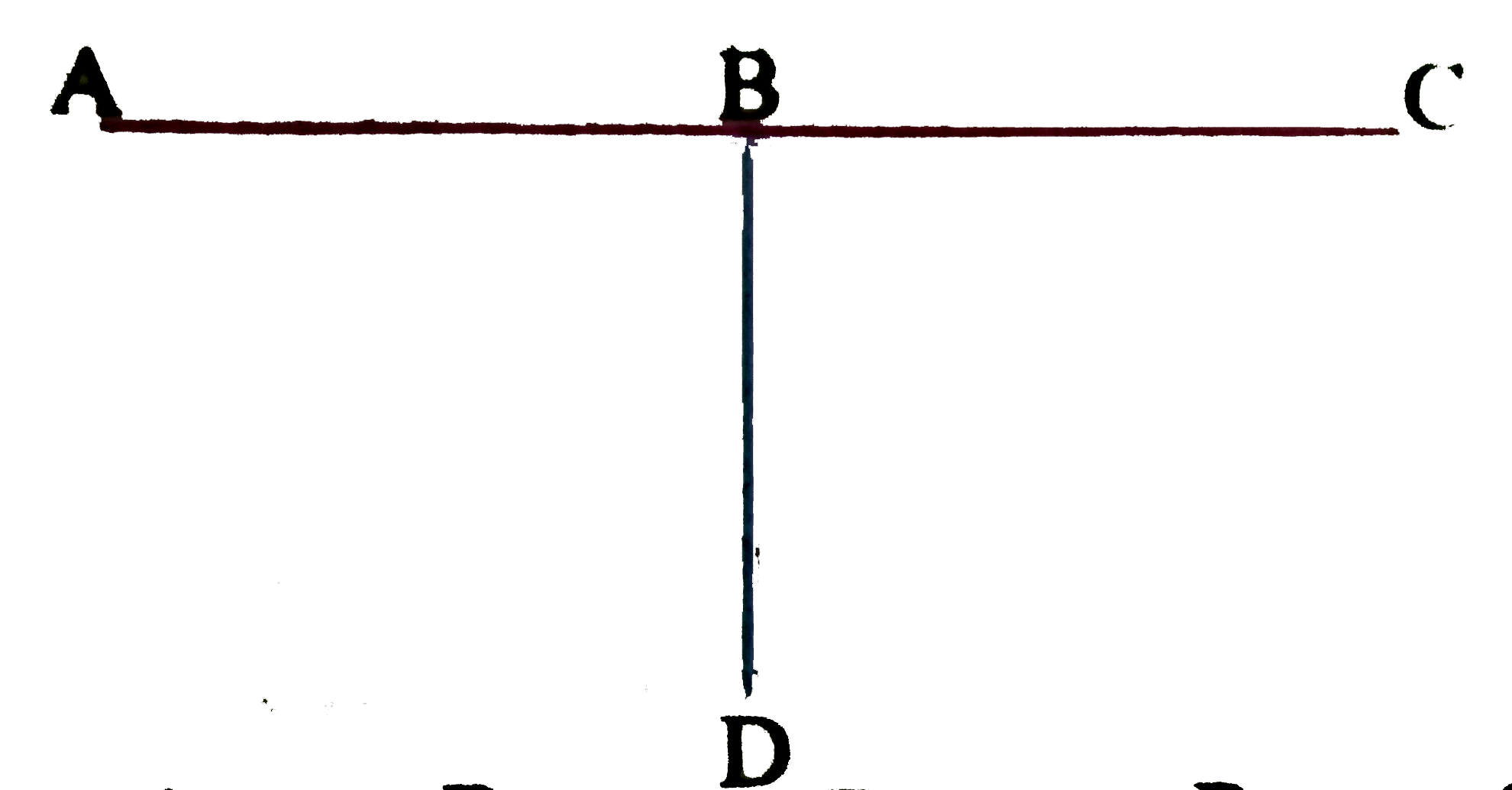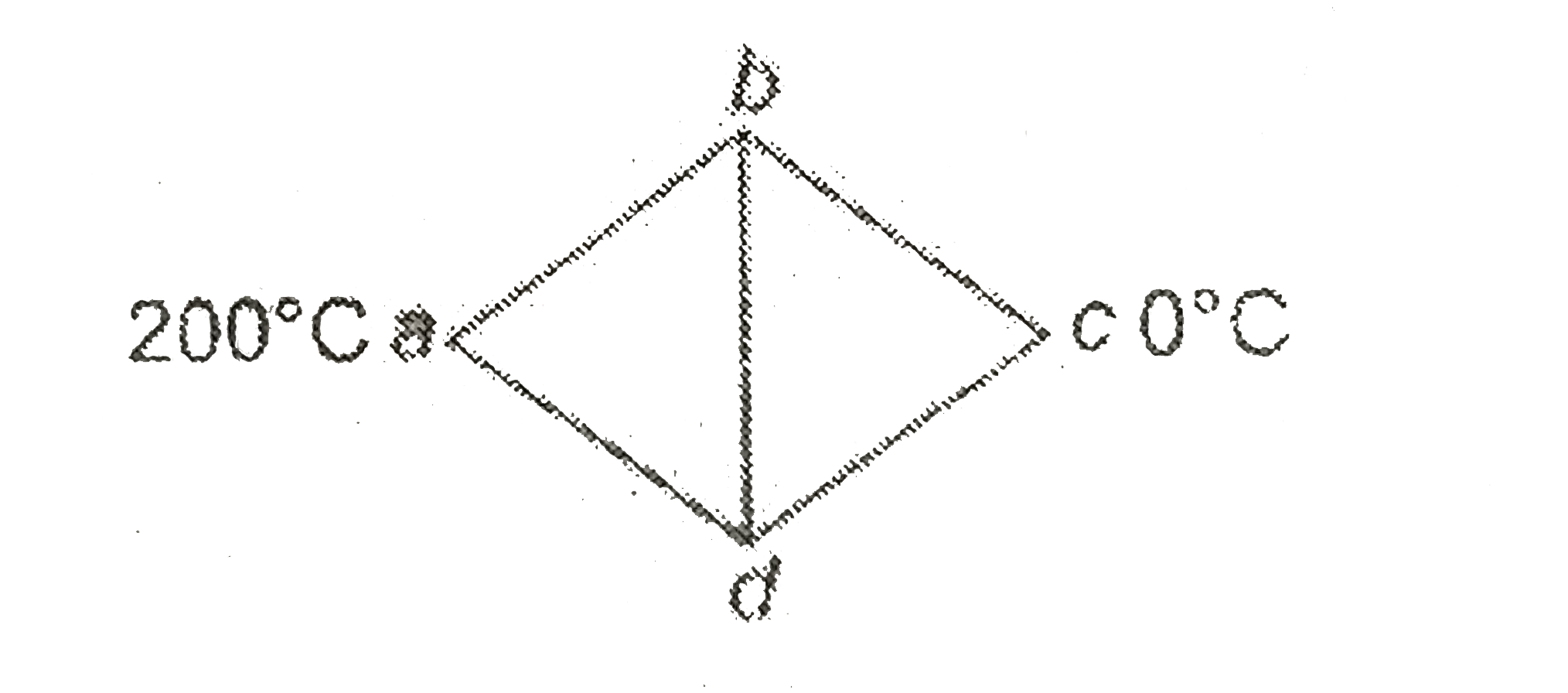Three rods of equal length of same material are joined to form an equivalent triangle ABC as shown figure. Area of cross-section of rod AB is S of rod BC is 2S and that of AC is S , then
_E01_150_Q01.png)
Column-IColumn-II(A)Temperature of junctionB(p)Greater than50∘C(B)Heat current inAB(q)Less than50∘C(C)Heat current in BC(r)Is equal to current in BC(s)Is 23times heat current in AC(t)NoneSolution in Gujrati
Let RBC=R then RAB=RAC=2R as R=lkA
100−TB2R=TB−0R⇒TB=67.7∘C
(ΔQΔt)AB=(ΔQΔt)BC and (ΔQΔt)AB=23(ΔQΔt)AC
Topper's Solved these Questions
- GEOMETRICAL OPTICSBOOK - ALLEN CHAPTER - GEOMETRICAL OPTICSEXERCISE - ASSERTION-REASON
40 Videos
- GEOMETRICAL OPTICSBOOK - ALLEN CHAPTER - GEOMETRICAL OPTICSEXERCISE - Comprehension Based Questions
66 Videos
- GEOMETRICAL OPTICSBOOK - ALLEN CHAPTER - GEOMETRICAL OPTICSEXERCISE - EXERCISE -02
82 Videos
- CURRENT ELECTRICITYBOOK - ALLEN CHAPTER - CURRENT ELECTRICITYEXERCISE - EX.II
66 Videos
- GRAVITATIONBOOK - ALLEN CHAPTER - GRAVITATIONEXERCISE - EXERCISE 4
9 Videos
Similar Questions
Statement-1: A real gas behaves as an ideal gas at high temperature and low pressure .
Statement-2: Liquid state of an ideal gas is impossible.
View SolutionA certain amount of ice is supplied heat at a constant rate for 7 min. For the first one minute the temperature rises uniformly with time. Then it remains constant for the next 4 min and again the temperature rises at uniform rate for the last 2 min. Given Sice=0.5cal/g∘C,Lf=80cal/g.
The initial temperature of ice is
View SolutionA triangular plate has two cavities , one square and one rectangular as shown in figure . The plate is heated.
_E01_066_Q01.png)
View SolutionIn the Bohr's model of hy drogen atom, the electron moves around the nucleus in a circular orbit of radius 5×10−11m. Its time period is 1.5×10−16s. The current associated with the electron motion is:-
View SolutionAssertion : The difference in the value of acceleration due to gravity at pole and equator is proportional to square of angular velocity of earth.
Reason : the value of acceleration due to gravity is minimum at the equator and maximum at the pole.
View SolutionThree rods of lengths 20cm eac h and area of cross section 1cm2 are joined to from a triangle ABC. The conductivites of the rods are kAB=50Js−1m−1(@)C^(-1),k_(BC)=200Js^(-1)m^(-1)(∘)C−1 , and kAC=400Js−1m−1(@)C^(-1).ThejunctionA,BandCarema∫a∈edat40^(@)C,80^(@)Cand80^(@)C respectivelt. Find the rate of heat flowing through the rods AB, AC and BC .
View SolutionThree rods AB,BC and BD made of the same materical and having the same area of cross section have been joined as shown is the The ends A,C and D are held at temperatures 20∘C Cand 80∘C respectively If each rod is of same length then find the temperature at the junction B of the three rods
 .
.
View Solution(a) Three rod of lengths 20cm each and area of cross-section 1cm2 are joined to form a triangle ABC. The conductivities of the rods are KAB=50J/m−s−.∘C,KBC=200J/m−s−.∘C and KAC=400J/m−s−.∘C. The junctions A,B and C are maintained at 40∘C, 80∘C and 80∘C respectively. Find the rate of heat flowing through the rods AB,AC and BC.
(b) A semicircular rod is joineted as its end to a straight rod of the same material and the same cross-sectional area. The straight rod forms a diameter of the other rod. The junctions are maintained at different temperatures. Find the ratio of the heat transferred through a cross-section of the simicircular rod to the heat transferred through a cross-section of the straight rod in a given time.
View SolutionThree rods A, B and C of the same length and cross- sectional area are joined in series as shown. The temperature at the junction of A and B , in equilibriu, is
View SolutionFive rods of same material and same cross-section are joined as shown. Lengths of rods ab, ad and bc are l, 2l and 3l respectively. Ends a and c are maintained at temperatures 200∘C and 0∘C respectivelly.

For what length x of rod dc there will be no heat flow through rod bd ?
View SolutionThree rods of equal length of same material are joined to form an equilateral triangle ABC as shown in figure. Area of cross-section of rod AB is S, of rod BC is 2S and that of AC is S. Then match the following.
View SolutionThree conducting rods of same material and cross-section are shown in figure. Temperatures of A,D and C are maintained at 20^(@)C, 90^(@)C and 0^(@)C . The ratio of lengths BD and BC if there is no heat flow in AB is
View SolutionThree rods of equal length of same material are joined to form an equivalent triangle ABC as shown figure. Area of cross-section of rod AB is S of rod BC is 2S and that of AC is S , then {:(,"Column-I",,"Column-II"),((A),"Temperature of junction" B,(p),"Greater than" 50^(@)C),((B),"Heat current in" AB,(q),"Less than" 50^(@)C),((C),"Heat current in BC",(r),"Is equal to current in BC"),(,,(s),"Is " 2/3 "times heat current in AC"),(,,(t),"None"):}
View Solutionयदि a,b,c में से कोई शून्य नहीं है तो दिखाएँ कि
Δ=∣∣ ∣ ∣∣−bcb2+bcc2+bca2+ac−acc2+aca2+abb2+ab−ab∣∣ ∣ ∣∣=(bc+ca+ab)3
View SolutionThree rods of lengths 20cm each and area of cross section 1cm2 are joined to from a triangle ABC. The conductivities of the rods are kAB=50Js−1m−1C−1 , kBC=200Js−1m−1C−1 , and kAC=400Js−1m−1C−1 . The junction A,B and C are maintained at 40∘C , 80∘C and 80∘C respectively. Find the rate of heat flowing through the rods AB, AC and BC .
View SolutionThree rods of lengths 20cm each and area of cross-section 1cm^(2) are joined to form a triangle ABC. The conductivities of the rods are K_(AB)=50J//m-s-^(0)C,K_(BC)=200J//m-s-""^(0)C and K_(AC)=400J//m-s-""^(0)C . The junctions A, B and C are maintained at 40^(@)C,80^(@)C and 80oC respectively. The rate of heat flowing through the rod AB is __________ W
View Solution
